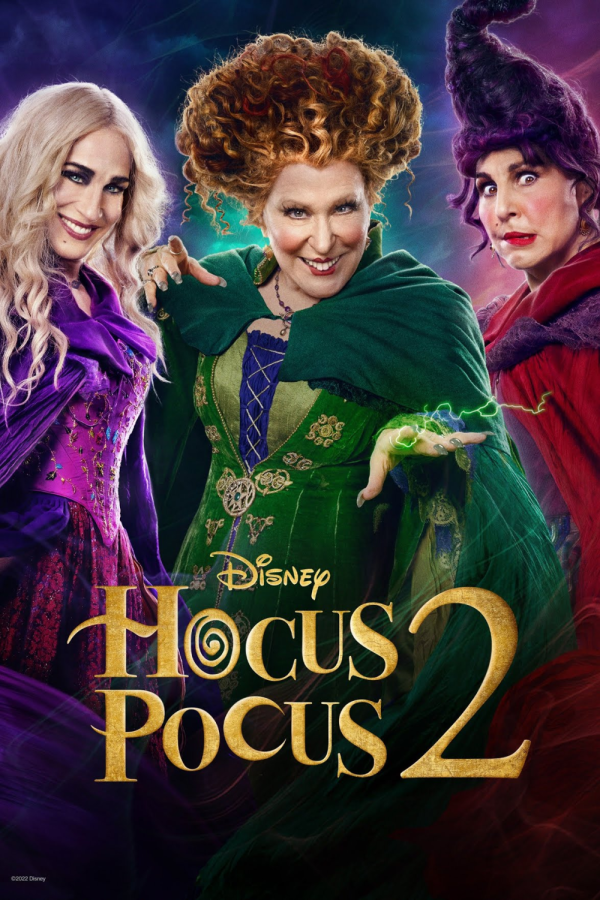“Hocus Pocus 2”: A Nostalgic Cash Grab
October 11, 2022
The sequel to the classic Halloween movie “Hocus Pocus”, which was released on Disney+ on Sept. 30, has left mixed impressions among viewers. The new film has garnered everything from articles of praise to fear of legitimately malignant witchcraft inside the movie. Released in 1993, the first “Hocus Pocus” film follows Max, a high school boy, alongside his younger sister and love interest, on their quest to stop the three evil Sanderson witches from terrorizing the town of Salem, Massachusetts. The witches, who are sisters that are accidentally summoned from the year 1693, are in search of children to steal to obtain their essence and consequentially, youth. Bette Midler plays the spunky leader of the sisters as Winifred Sanderson. Sarah Jessica Parker takes on a ditzy blonde persona for the role of Sarah Sanderson, and Kathy Najimy caps the trio as the wonderfully endearing, Baba Yaga-esque character of Mary Sanderson. Despite the movie’s modern cementation as a classic, it was not originally a hit. An article from No Film School says, “’Hocus Pocus’ went from a massive flop ($39 million domestic on a $28 million budget) in 1993 to one of the most popular Halloween movies of all time.”
In my opinion, the sequel is completely mediocre. Within this sequel lies many glaring faults that prompt larger conversations about the state of Hollywood today. Firstly, the film heavily relies on nostalgia to generate a positive audience reaction. Many minutes of the film are filled completely by copy-and-pasting clips from the first Hocus Pocus. Disney’s live-action remakes, unremarkable biopics, and any piece of the Marvel franchise are all similar examples of rebooting and exploiting nostalgia for quick money. Cosmopolitan says, “The shows and films you grew up with are back. Re-packaged, re-modelled and re-marketed, but still faintly recognizable.” This rebooting and remaking of old content guarantees moviemakers some level of success but represents a startling drought of creativity. Heavy product placement also exists in the movie, strategically posting advertisements for a multitude of companies as the Sanderson sisters walk through the skincare aisle of a Walgreens. Yes, that is a real scene from the movie.
Additionally, the writing of this film appeared to be afraid of making any imaginative choices, relying on the motifs and iconic lines of its predecessor. The storyline is predictable and uninteresting, featuring bland protagonists Becca, Izzy and Cassie, who demonstrate a corny “friendship is magic” lesson by the end of the movie. The conclusion of the film was solid, however, effectively wrapping up the franchise with the peaceful dissolution of the Sanderson sisters.
The movie was severely lackluster in dialogue. The first “Hocus Pocus” gave us quotable lines like Winifred’s “Another glorious morning … makes me sick!” and Mary’s “You know, I’ve always wanted a child. And now I think I’ll have one on toast!” “Hocus Pocus 2” gave us Izzy, who cringe-inducingly remarked “That’s a big ole yikes!” whenever in trouble. It also added the unnecessary character of ‘Witch Mother’ (who exists for a brief moment and then was never mentioned again) wearing out tongue-in-cheek feminism tropes in her quote, “The world is not too fond of witches. Can’t imagine why.”
Sequels will always be worse than an original movie, with few exceptions. Therefore, it’s not unbelievable that “Hocus Pocus 2” is sub-par compared to the first film. However, it would be a step in the right direction if other filmmakers learned from the faults of this movie and worked towards a future of creative, worthwhile cinema.



